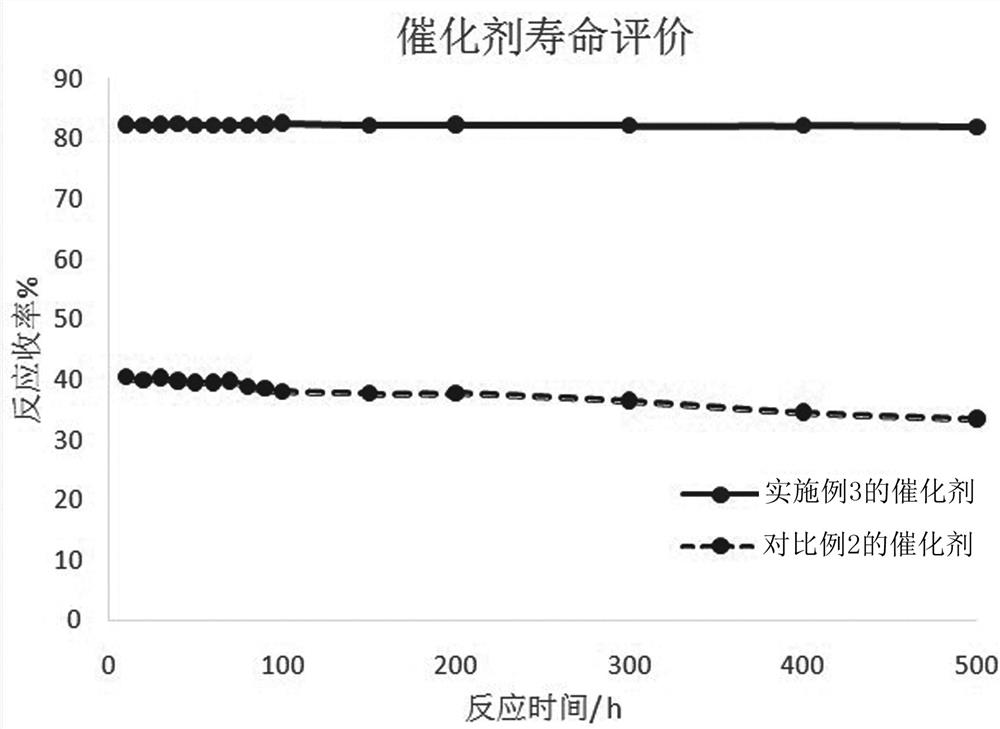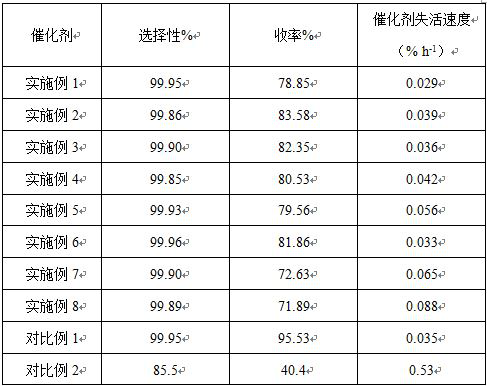Regeneration method of gold-carbon catalyst for preparing VCM
A technology of gold-carbon catalyst and deactivated catalyst is applied in the field of regeneration of gold-carbon catalyst, which can solve the problems of easy deactivation and short life of the catalyst, and achieve the effects of strong operability, stable life and convenient recovery.
- Summary
- Abstract
- Description
- Claims
- Application Information
AI Technical Summary
Problems solved by technology
Method used
Image
Examples
Embodiment 1
[0032] A kind of regeneration method that is used to prepare the gold-carbon catalyst of VCM, comprises the following steps:
[0033] (1) One washing: take 100mL of deactivated catalyst, add 300mL of dichloromethane, stir for 2h, filter, repeat the operation 3 times, that is, wash the deactivated catalyst with dichloromethane for 3 times, and then dry at 120°C for 4h;
[0034] (2) Second washing: take the product of step (1), add 300mL of glacial acetic acid, stir for 2h, filter, repeat the operation 3 times, that is, wash the deactivated catalyst with glacial acetic acid for 3 times, and then dry at 120°C for 4h ;
[0035] (3) Roasting: Roasting at 800°C for 5 hours under a nitrogen atmosphere;
[0036] (4) Chemical reaction: Add 300mL of 0.2mol / L sodium citrate solution, stir for 3h, then wash with pure water, and dry at 120°C for 4h;
[0037] (5) Heat treatment: heat treatment at 200°C for 3 hours under nitrogen atmosphere.
Embodiment 2
[0039] A kind of regeneration method that is used to prepare the gold-carbon catalyst of VCM, comprises the following steps:
[0040] (1) One wash: take 100mL of deactivated catalyst, add 300mL of tetrahydrofuran, stir for 2h, filter, repeat the operation 3 times, that is, wash the deactivated catalyst with tetrahydrofuran for 3 times, and then dry at 120°C for 4h;
[0041] (2) Second washing: take the product of step (1), add 300mL of glacial acetic acid, stir for 2h, filter, repeat the operation 3 times, that is, wash the deactivated catalyst with glacial acetic acid for 3 times, and then dry at 120°C for 4h ;
[0042] (3) Roasting: Roasting at 800°C for 5 hours under a nitrogen atmosphere;
[0043] (4) Chemical reaction: Add 300mL of 0.2mol / L sodium citrate solution, stir for 3h, then wash with pure water, and dry at 120°C for 4h;
[0044] (5) Heat treatment: heat treatment at 200°C for 3 hours under nitrogen atmosphere.
Embodiment 3
[0046] A kind of regeneration method that is used to prepare the gold-carbon catalyst of VCM, comprises the following steps:
[0047] (1) One wash: Take 100mL of deactivated catalyst, add 300mL of absolute ethanol, stir for 2h, filter, repeat the operation 3 times, that is, wash the deactivated catalyst with absolute ethanol for 3 times, and then dry at 120°C for 4h;
[0048] (2) Second washing: take the product of step (1), add 300mL of glacial acetic acid, stir for 2h, filter, repeat the operation 3 times, that is, wash the deactivated catalyst with glacial acetic acid for 3 times, and then dry at 120°C for 4h ;
[0049] (3) Roasting: Roasting at 800°C for 5 hours under a nitrogen atmosphere;
[0050] (4) Chemical reaction: Add 300mL of 0.2mol / L sodium citrate solution, stir for 3h, then wash with pure water, and dry at 120°C for 4h;
[0051] (5) Heat treatment: heat treatment at 200°C for 3 hours under nitrogen atmosphere.
PUM
 Login to View More
Login to View More Abstract
Description
Claims
Application Information
 Login to View More
Login to View More - R&D
- Intellectual Property
- Life Sciences
- Materials
- Tech Scout
- Unparalleled Data Quality
- Higher Quality Content
- 60% Fewer Hallucinations
Browse by: Latest US Patents, China's latest patents, Technical Efficacy Thesaurus, Application Domain, Technology Topic, Popular Technical Reports.
© 2025 PatSnap. All rights reserved.Legal|Privacy policy|Modern Slavery Act Transparency Statement|Sitemap|About US| Contact US: help@patsnap.com


